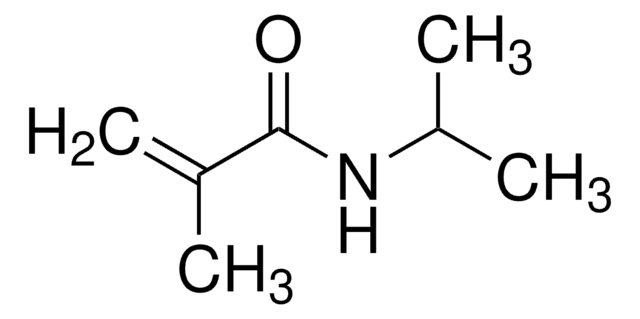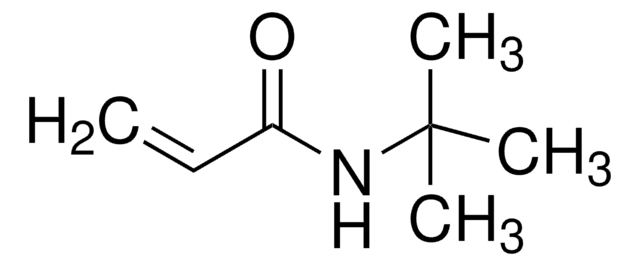Key Documents
731129
N-Isopropylacrylamide
≥99%
Synonim(y):
NIPAM
About This Item
Polecane produkty
Poziom jakości
Próba
≥99%
Postać
flakes
tw
89-92 °C/2 mmHg (lit.)
mp
60-63 °C (lit.)
63-67 °C
temp. przechowywania
2-8°C
ciąg SMILES
CC(C)NC(=O)C=C
InChI
1S/C6H11NO/c1-4-6(8)7-5(2)3/h4-5H,1H2,2-3H3,(H,7,8)
Klucz InChI
QNILTEGFHQSKFF-UHFFFAOYSA-N
Szukasz podobnych produktów? Odwiedź Przewodnik dotyczący porównywania produktów
Opis ogólny
Zastosowanie
N-Isopropylacrylamide can also be used as a key component in:
- The synthesis of self-powered multifunctional organic hydrogel based on poly(acrylic acid-N-isopropyl acrylamide) for flexible sensing devices.
- The development of a new type of flexible and stable gel electrolyte for aqueous Zn-MnO2 batteries.
- The preparation of poly(N-isopropylacrylamide/itaconic acid) (PNIPAM/IA) copolymeric hydrogels for drug delivery applications.
- The synthesis of poly(N-isopropylacrylamide) (PNIPAM) polymer for the development of a new class of polymer-grafted semiconductor devices.
Hasło ostrzegawcze
Danger
Zwroty wskazujące rodzaj zagrożenia
Zwroty wskazujące środki ostrożności
Klasyfikacja zagrożeń
Acute Tox. 4 Oral - Eye Dam. 1
Kod klasy składowania
11 - Combustible Solids
Klasa zagrożenia wodnego (WGK)
WGK 3
Wybierz jedną z najnowszych wersji:
Masz już ten produkt?
Dokumenty związane z niedawno zakupionymi produktami zostały zamieszczone w Bibliotece dokumentów.
Klienci oglądali również te produkty
Produkty
Poly(N-isopropylacrylamide), or PNIPAM, is a stimuli-responsive polymer that responds to changes in pH and temperature and has a LCST around 32 C.
Inżynieria tkankowa stała się kluczowym narzędziem terapeutycznym w leczeniu uszkodzonych lub chorych narządów i tkanek, takich jak naczynia krwionośne i pęcherze moczowe.
Tissue engineering has become a key therapeutic tool in the treatment of damaged or diseased organs and tissues, such as blood vessels and urinary bladders.
Nasz zespół naukowców ma doświadczenie we wszystkich obszarach badań, w tym w naukach przyrodniczych, materiałoznawstwie, syntezie chemicznej, chromatografii, analityce i wielu innych dziedzinach.
Skontaktuj się z zespołem ds. pomocy technicznej












